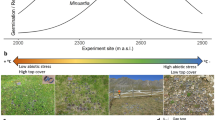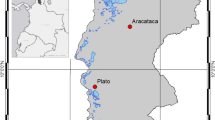Abstract
A seed size–seed number trade-off exists because smaller seeds are produced in greater number but have a lower probability of establishment. This reduced establishment success of smaller-seeded species may be determined by biophysical constraints imposed by scaling rules. Root and shoot diameter, root growth extension rate (R GER) and shoot length at death for dark-grown seedlings are predicted to scale with the cube root of seed embryo and endosperm mass (m). We confirmed this expectation for ten neotropical gap-dependent tree species with an embryo and endosperm dry mass >1 mg. However, for nine smaller seeded species (m < 1 mg) with photoblastic germination, root and shoot diameters were larger than expected, and consequently, R GER was slower than expected. The maximum shoot thrust of seedlings from seeds with masses ≥1 mg was comparable to the estimated force required to displace overlying litter, supporting the hypothesis that photoblastic behaviour only occurs in seeds with insufficient shoot thrust to displace overlying leaves. Using the model soil water, energy and transpiration to predict soil drying in small and large gaps, we showed that: (1) gaps that receive a significant amount of direct sunlight will dry more quickly than small gaps that do not, (2) compared to the wet-season, soil that is already dry at depth (i.e. the dry-season) will dry faster after rainfall (this drying would most likely kill seedlings from small seeds) and (3) even during the wet-season, dry periods of a few days in large gaps can kill shallow-rooted seedlings. We conclude that the smaller the seed, the more vulnerable its seedling would be to both covering by litter and soil drying because it can only emerge from shallow depths and has a slow R GER. Consequently, we suggest that these allometrically related factors contribute to the reduced establishment success of smaller-seeded species that underpins the seed size–seed number trade-off.





Similar content being viewed by others
References
Armstrong DP, Westoby M (1993) Seedlings from large seeds tolerate defoliation better: a test using phylogenetically independent contrasts. Ecology 74:1092–1100
Bohonak AJ (2004) RMA: Software for reduced major axis regression. http://www.bio.sdsu.edu/pub/andy/rma.html
Bond WJ, Honig M, Maze KE (1999) Seed size and seedling emergence: an allometric relationship and some ecological implications. Oecologia 120:132–136
Boot RGA (1996) The significance of seedling size and growth rate of tropical rain forest tree seedlings for regeneration in canopy openings. In: Swaine MD (ed) The ecology of tropical forest tree seedlings. UNESCO, Paris, pp 267–283
Brokaw NVL (1987) Gap-phase regeneration of three pioneer tree species in a tropical forest. J Ecol 75:9–19
Buckley RC (1982) Seed size and seedling establishment in tropical arid dunecrest plants. Biotropica 14:314–315
Burke EJ, Gurney RJ, Simmonds LP, Jackson TJ (1997) Calibrating a soil water and energy budget model with remotely sensed data to obtain quantitative information about the soil. Water Resour Res 33:1689–1697
Coomes DA, Grubb PJ (2003) Colonization, tolerance, competition and seed-size variation within functional groups. Trends Ecol Evol 18:283–291
Daamen CC (1997) Two source model of surface fluxes for millet fields in Niger. Agric For Meteorol 83:205–230
Daamen CC, Simmonds LP (1994) SWEAT – a numerical model of water and energy fluxes in soil profiles and sparse canopies, manual. University of Reading, Reading, UK
Daamen CC, Simmonds LP (1996) Measurement of evaporation from bare soil and its estimation using surface resistance. Water Resour Res 32:1393–1402
Dalling JW, Burslem DFRP (2005) Role of trade-offs in the equalization and differentiation of tropical tree species. In: Burslem DFRP, Pinard MA, Hartley SE (eds) Biotic interactions in the tropics. Cambridge University Press, Cambridge, pp 65–88
Dalling JW, Hubbell SP (2002) Seed size, growth rate and gap microsite conditions as determinants of recruitment success for pioneer species. J Ecol 90:557–568
Daws MI (2002) Mechanisms of plant species coexistence in a semi-deciduous tropical forest in Panamá. PhD thesis. University of Aberdeen, Aberdeen, UK
Daws MI, Mullins CE, Burslem DFRP, Paton SR, Dalling JW (2002) Topographic position affects the water regime in a semideciduous tropical forest in Panama. Plant Soil 238:79–90
Daws MI, Pearson TRH, Burslem DFRP, Mullins CE, Dalling JW (2005) Effects of topographic position, leaf litter and seed size on seedling demography in a semi-deciduous tropical forest in Panama. Plant Ecol 179:93–105
Dietrich WE, Windsor DM, Dunne T (1982) Geology, climate and hydrology of Barro Colorado Island. In: Leigh EG Jr, Rand AS, Windsor DM (eds) The ecology of a tropical forest: seasonal rhythms and long-term changes. Smithsonian Institution Press, Washington D.C., pp 21–46
Engelbrecht BMJ, Dalling JW, Pearson TRH, Wolf RL, Gálvez DA, Koehler T, Tyree MT, Kursar TA (2006) Short dry spells in the wet season increase mortality of tropical pioneer seedlings. Oecologia 148:258–269
Fenner M (1983) Relationships between seed weight, ash content and seedling growth in twenty four species of Compositae. New Phytol 95:697–706
Gordon JE (1978) Structures or why things don’t fall down. Penguin Books, London
Grubb PJ, Burslem DFRP (1998) Mineral nutrient concentrations as a function of seed size within seed crops: implications for competition among seedlings and defence against herbivory. J Trop Ecol 14:177–185
Harms KE, Dalling JW (1997) Damage and herbivory tolerance through resprouting as an advantage of large seed size in tropical trees and lianas. J Trop Ecol 13:617–621
Harms KE, Wright SJ, Calderon O, Hernandez A, Herre EA (2000). Pervasive density-dependent recruitment enhances seedling diversity in a tropical forest. Nature 404:493–495
Hudson N (1971) Soil conservation. BT Batsford, London
International Seed Testing Association (1999) International rules for seed testing. Seed Sci Technol 27[Suppl]
Kyereh B, Swaine MD, Thompson J (1999) Effect of light on the germination of forest trees in Ghana. J Ecol 87:772–783
Leishman MR, Murray BR (2001) The relationship between seed size and abundance in plant communities: model predictions and observed patterns. Oikos 94:151–161
Marshall TJ, Holmes JW, Rose CW (1996) Soil Physics. Cambridge University Press, Cambridge
Morgan RPC (1995) Soil erosion and conservation. Longmans Group, Harlow, 198 pp
Pearson TRH, Burslem DFRP, Mullins CE, Dalling JW (2002) Germination ecology of neotropical pioneers, interacting effects of environmental conditions and seed size. Ecology 83:2798–2807
Pearson TRH, Burslem DFRP, Mullins CE, Dalling JW (2003a) Functional significance of photoblastic germination in neotropical pioneer trees: a seed’s eye view. Funct Ecol 17:398–402
Pearson TRH, Burslem DFRP, Goeriz RE, Dalling JW (2003b) Interactions of gap size and herbivory on establishment, growth and survival of three species of neotropical pioneer trees. J Ecol 91:785–796
Poorter L (2005) Resource capture and use by tropical forest tree seedlings and their consequences for competition. In: Burslem DFRP, Pinard MA, Hartley SE (eds) Biotic interactions in the tropics. Cambridge University Press, Cambridge, pp 35–64
Poorter L, Hayashida-Oliver Y (2000) Effects of seasonal drought on gap and understorey seedlings in a Bolivian moist forest. J Trop Ecol 16:481–498
Rand AS, Rand WM (1982) Variation in rainfall on Barro Colorado Island. In: Leigh. Jr. EG, Rand AS, Windsor DM (eds) The ecology of a Neotropical forest: seasonal rhythms and longterm changes. Smithsonian Institution Press, Washington D.C., pp 47–59
Raven JA (1999) The minimum size of seeds and spores in relation to the ontogeny of homoiohydric plants. Funct Ecol 13:5–14
Underwood AJ (1997) Experiments in ecology. Cambridge University Press, Cambridge
Vázquez-Yanes C, Orozco-Segovia A, Rincon E. Sanchez-Coronad ME, Huante P, Toledo JR, Barradas VL (1990) Light beneath the litter in a tropical forest: effect on seed germination. Ecology 71:1952–1958
Veenendaal EM, Swaine MD, Agyeman VK, Blay D, Abebrese IK, Mullins CE (1996) Differences in plant and soil water relations in and around a forest gap in West Africa during the dry season may influence seedling establishment and survival. J Ecol 84:83–90
Weaich K, Bristow KL, Cass A (1992) Preemergent shoot growth of maize under different drying conditions. Soil Sci Soc Am J 56:1272–1278
Westoby M, Leishman M, Lord J (1996) Comparative ecology of seed size and dispersal. Philos Trans R Soc Lond B 351:1309–1318
Yavitt JB, Battles JJ, Lang GE, Knight DH (1995) The canopy gap regime in a secondary neotropical forest in Panama. J Trop Ecol 11:391–402
Acknowledgements
We thank Sam Arr-Jones for technical assistance, Jim Dalling, Evelyn Sanchez and Camilla Pisano for help in providing seeds, Hazel Cleland for measuring shoot bucking forces and Norval Strachan for help with running SWEAT. This work was partly funded by the Natural Environment Research Council.
Author information
Authors and Affiliations
Corresponding author
Rights and permissions
About this article
Cite this article
Daws, M.I., Ballard, C., Mullins, C.E. et al. Allometric relationships between seed mass and seedling characteristics reveal trade-offs for neotropical gap-dependent species. Oecologia 154, 445–454 (2007). https://doi.org/10.1007/s00442-007-0848-2
Received:
Accepted:
Published:
Issue Date:
DOI: https://doi.org/10.1007/s00442-007-0848-2




